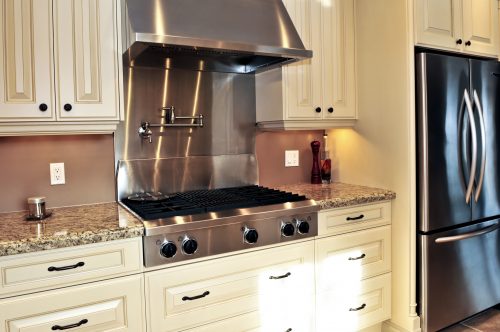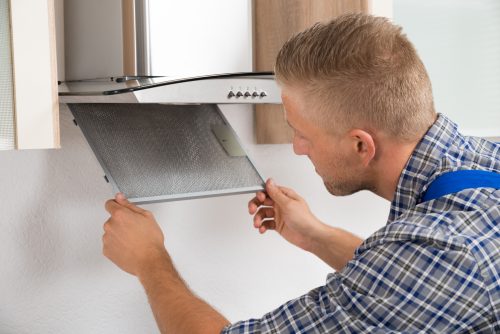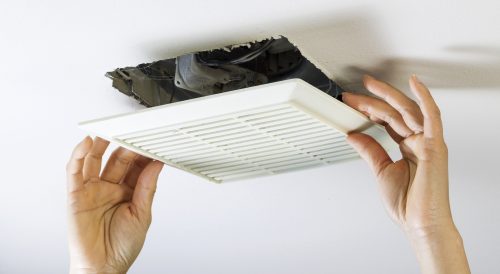Welcome to the Take Charge of Your Home series from Direct Energy! Hiring a professional to perform household maintenance may offer convenience and peace of mind, but you can do many of these jobs yourself with no experience or special tools. And in the process, you’ll save money, learn about how your home works and gain a sense of accomplishment from a DIY task done well! Kitchen and bathroom exhaust fans are among the most underappreciated systems in today’s homes. They’re easy to forget about when it comes to home maintenance, and they can sometimes malfunction without homeowners even noticing. But when they’re used properly and well maintained, they can make any home safer, more energy efficient and fresher-smelling.
What Do Exhaust Fans Do?
Your bathroom and kitchen exhaust fans share the same primary function: to move air from those rooms and vent it outside the home. But there are big differences in the benefits these two types of exhaust fans offer. In bathrooms, the exhaust fan’s most important job is to remove steam produced by hot showers. Most bathrooms are small and few have large, easy-to-open windows to assist with ventilation, so the exhaust fan is often the only escape route for steam. If there’s nowhere for steam to go, it will turn into condensation on every surface in the bathroom. In the short term, this will produce mildew, mold and all kinds of funky odors. Over the long haul, it can peel wallpaper, rot drywall and even warp wood trim and furnishings. Bathroom exhaust fans also do double-duty by clearing out unpleasant bathroom odors. In the kitchen, exhaust fans are located either in a hood above the stove or as part of an above-range microwave assembly. Like the bathroom fan, it pulls away steam from pots of boiling water so that the humid air can’t damage your kitchen. But it also removes strong cooking aromas, clears smoke from failed baking experiments and keeps cooktops clean by sucking up grease particles. It’s even good for expelling warm air when using the oven during summer, giving your air conditioner a little break.When to Use Your Exhaust Fans
In the bathroom, feel free to run the exhaust fan anytime you think the air could use some freshening up. But you should always run it during hot showers and for about 20 minutes afterward, or until the steamy air is completely removed. It’s often a good idea to run the kitchen exhaust fan whenever you’re cooking on the range, but personal preferences will vary. Kitchen fans also remove cooking smells, and some home cooks might see it as a waste to let all those delectable aromas escape. The most important times to run the exhaust fan are when cooking with oil or grease, boiling water or clearing smoke. From an energy efficiency perspective, it’s also important to remember to turn the fans off when they’re no longer needed. If your fans are quiet, it can be easy for this to go unnoticed. Some sophisticated models have built-in timers or sensors that turn them on and off automatically, but these features aren’t the norm.
How to Clean a Bathroom Exhaust Fan
- You should clean your bathroom’s exhaust fan at least once a year. Before starting, shut off the power to the fan at the circuit box.
- Stand on a sturdy step stool to get a good look at the grate that covers your fan. It might be held in place by screws, but most modern fan grates are held in place with easy-to-remove tension clips that don’t require tools. After removing the grate, wash it with warm water and dish soap.
- Remove as much dust as possible from the fan assembly using a vacuum wand attachment or a can of compressed air. Follow up with a dusting cloth to get whatever dust remains.
- After that, just dry and replace the grate. Don’t forget to turn the circuit breaker back on!
How to Clean a Kitchen Exhaust Fan
Kitchen hood exhaust fans should also be cleaned at least once a year and can be a little more complex, so we recommend referring to the model-specific documentation whenever possible. If you don’t have your fan’s original manual, look for a label with a model number to help you look this information up online. There are two important reasons to seek out model-specific cleaning instructions, and they have one thing in common: grease. Kitchen exhaust fans have grease filters that prevent your vent pipe from getting gummed up, and while most kitchen exhaust fan mesh filters can be cleaned and reused, some are designed to be thrown away and replaced. You’ll also want to check your fan’s documentation for an approved list of cleaning materials for removing grease from fan blades and other components. No matter how hard your filter works, there will always be a little grease that gets through, and cleaning your greasy kitchen exhaust fan blades thoroughly may take a little time and elbow grease. If your fan uses reusable filters, the most effective way to remove built-up grease is often to soak them in boiling water for several minutes, then scrub with hot soapy water and a nylon bristle brush. And as with your bathroom fan, always shut off the power at the circuit breaker before cleaning.


